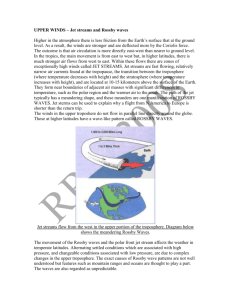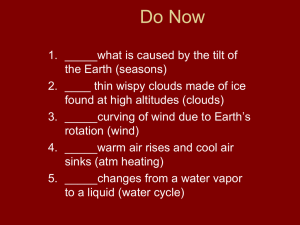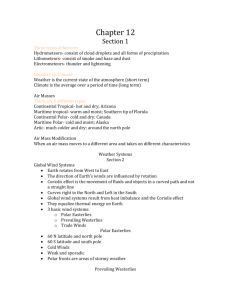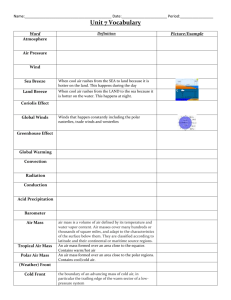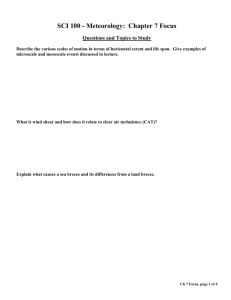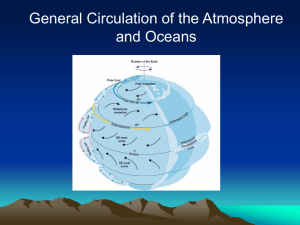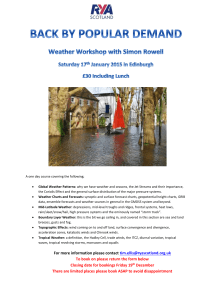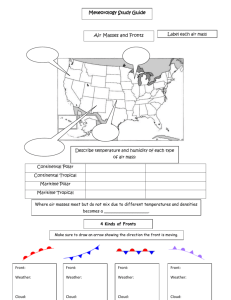Atmosphere and Weather 2
advertisement
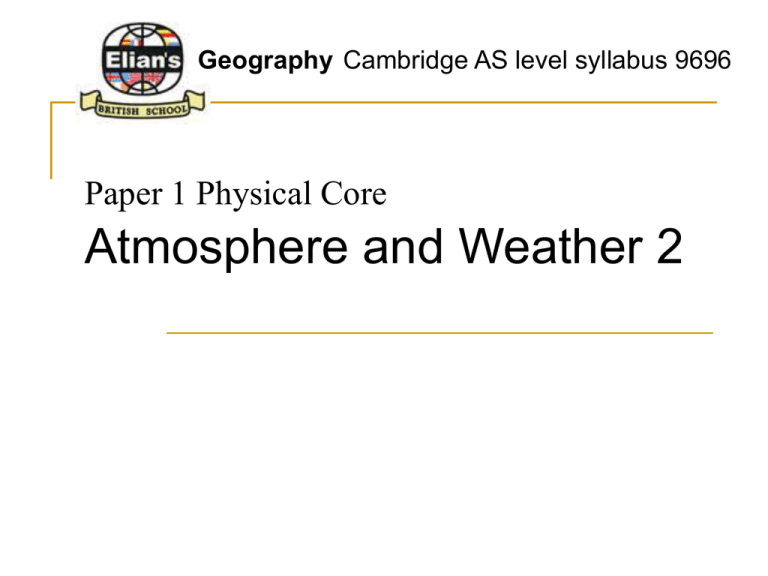
Geography Cambridge AS level syllabus 9696 Paper 1 Physical Core Atmosphere and Weather 2 Global Circulation at Upper Levels: Rossby Waves are found in the upper-air westerly circulation of middle and high latitudes Jet Stream Jet streams: high-speed air flow in narrow bands within the upper-air westerlies and along certain other global latitude zones at high levels Jet Streams Jet streams form the BOUNDARIES of the Westerlies. There are 2 types: polar and subtropical. They are high speed winds, and 60 knots is the minimum to qualify. See Fig 5-24, pg 122. Whenever the paths of jet streams change or meander, they’re called “Rossby Waves”. Fig 2.23, p. 39. Rossby Waves, Jet Streams, and the Polar Front Rossby Waves: • Arise in the polar front • Contribute to variable weather in mid and high latitudes Rossby Waves: horizontal undulations in the flow path of the upper-westerlies; upper-air waves Polar front: zone where cold polar air meets warm tropical air Flow of air along front smooth for days or weeks. Waves stronger. Tongue of cold air brought south and warm north. Undulations begin and Become stronger. Rossby Wave forms. Warm air Pushed poleward, cold air south Tongue pinched off. Pool of cold air farther south than originally. Become cyclones of cold air Persist for days or weeks. General Surface Circulation •Polar Highs •Polar Easterlies •Subpolar Lows/Polar Front Polar-front jet stream • Westerly; associated with Rossby waves Subtropical jet stream • Westerly; above subtropical highpressure cells Tropical easterly jet stream • Runs east to west • Summer only • Develops in Asia Subtropical Highs (STHs) Formed by the high pressure created from descending air of Hadley Cells. They are giant anticyclones (characteristic?) They are persistent, and are found about 30 degrees N & S. Also called the “horse latitudes” (16th & 17th cent.) STHs are the source of Trade Winds & Westerlies. Horse Latitudes Subtropical Highs Responsible for the world’s greatest deserts. Dry conditions caused by no uplift of air due to high pressure. Trade Winds Major wind systems of the tropics, btw latitudes 25 degrees N & S. Dominates the earth more than any other wind system. They are Easterly (blow from East). That’s how winds are named (continued on next page). General Surface Circulation Trade winds are the most reliable of ALL winds – their direction & speed is extremely consistent (whether it be summer, winter, day or night). There is one exception (discussed later). Hence “trade winds”, mean “winds of commerce”. 16th century sailors found that it was the fastest & most reliable route from Europe to America. Intertropical Convergence Zone (ITCZ) This is where the Trade Winds converge. Known for low pressure & a lot of storms. Also called the “doldrums” (calm air) – even though it’s a zone of convergence, horizontal air flow is weak. The Westerlies Why are they called “Westerlies”? Found between 30 to 60 degrees N & S. Cyclonic Storms Extratropical Cyclones (nor’easterns) Created at the Polar Front. Involves two air masses. Meandering (wave) creates low pressure center. Air from both sides flow inward and begin rotating due to Coriolis effect (c.cw. in N.hemi.) Rising warm moist air condenses, fueling storm energy and creating strong wind and rains. Usually during winter when differences in air masses are extreme. Strongest winds hit northeast US and eastern Canada from the northeast (hence nor'eastern) Tropical Cyclones (hurricanes, typhoons, cyclones) Created by disturbances within a single tropical air mass. Genesis involved thunderstorms during periods of low wind shear. Tropical Cyclones: Move westward and poleward. Begins as a tropical depression over warm water (>25ºC). Most of the energy associated with a storm derives from the latent heat of evaporation which is given off during condensation of rising moist air in vertical thunderstorms. Creates intense low pressure. Coriolis effect initiates rotation of air as it moves inward toward the low pressure center = "eye". Upgrades to a hurricane when the wind velocity increases above 74 mph. Winds circulate around the eye in a counterclockwise direction in the northern hemisphere. Weakens when they travel over colder water or land. Low wind shear favors development! Mitch (Oct 1998) Tegucigalpa, Hondurus Geography Cambridge AS level syllabus 9696 Links for this topic on geogblogcostablanca.wordpress.com
